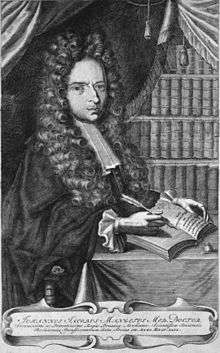Jean-Jacques Manget
Jean-Jacques Manget (or Johann Jacob Mangetus) (1652–1742) was a Genevan physician and writer. He was known for his work on epidemic diseases such as bubonic plague and tuberculosis. In addition to his own researches, he assiduously compiled preceding medical literature. With Théophile Bonet, he is considered one of the "great compilers" of knowledge in the areas of medicine, surgery and pharmacology.[1][2]:357 He also published a major collection of alchemical works, the Bibliotheca Chemica Curiosa (1702).

Life
He was born in Geneva, the son of a merchant. He graduated as a physician at the University of Valence in 1678. Later he became the Dean of the Valence medical faculty. Frederick III, Elector of Brandenburg made Manget his personal physician in 1699.[3]
Works
Manget was one of the first doctors to carry out studies of the pathological anatomy of miliary tuberculosis. He coined the term based on his observation of widespread tiny lesions like millet seeds in the liver, lungs, spleen, and mesentery.[4][1]:353
He published Traité de la Peste (Geneva: Philippe Planche, 1721), a major treatise on the bubonic plague, and was well known as a plague doctor.[5] Manget reported that the exotic new drug ipecac had been effectively used in the treatment of plague in Marseille.[6] He advised the adoption of draconian measures to ensure quarantine and prevent the transmission of plague. Such measures were reported to have been successful in Silesia.[7]
"All People and all Countries wishing to remain in a perfect state of health must pay continuous attention to what takes place among their neighbors. If rumors spread that a contagious disease is gaining a foothold, they must break of all communication and all exchanges with it. They must prohibit all inhabitants of both provinces, the infected and the healthy, from engaging in any sort of communication in the future, under any pretext, on pain of death: and for this decree to be religiously observed it will be important to post well-armed Soldiers on the borders, and to build gallows on all public roads; either to intimidate those who will want to leave the infected country or to hang on the spot those who will have defied the prohibition."[7]
He published a large collection of alchemical works, the Bibliotheca Chemica Curiosa (1702). Many of the 170 works included were already rare.[8][9]
 Bibliotheca chemica curiosa, 1702
Bibliotheca chemica curiosa, 1702 Physician in plague preventive costume, as described by Manget
Physician in plague preventive costume, as described by Manget Bibliotheca scriptorum medicorum, 1731
Bibliotheca scriptorum medicorum, 1731 Figure 1, Volume 1, Bibliotheca chemica curiosa
Figure 1, Volume 1, Bibliotheca chemica curiosa Figure 2, Volume 1, Bibliotheca chemica curiosa
Figure 2, Volume 1, Bibliotheca chemica curiosa Figure 7, Volume 1, Bibliotheca chemica curiosa
Figure 7, Volume 1, Bibliotheca chemica curiosa Figure 15, Volume 1, Bibliotheca chemica curiosa
Figure 15, Volume 1, Bibliotheca chemica curiosa Figures, page 898, Volume 2, Bibliotheca chemica curiosa
Figures, page 898, Volume 2, Bibliotheca chemica curiosa Figures, page 901, Volume 2, Bibliotheca chemica curiosa
Figures, page 901, Volume 2, Bibliotheca chemica curiosa
Bibliography
| Library resources about Jean-Jacques Manget |
| By Jean-Jacques Manget |
|---|
- Bibliotheca anatomica, two volumes (Geneva, 1685)
- Bibliotheca curiosa chemica, two volumes (Geneva, 1702)
- Bibliotheca medico-practica sive rerum medicarum thesaurus cumulatissimus: tomis octo comprehensis (Geneva, 1695)
Notes
- Taton, Rene (1964). History of Science. The Beginnings of Modern Science From 1450 to 1800. Basic Books.
- Stolberg, Michael. "Die »Bibliothecae« des Jean-Jacques Manget (1652–1742)". Harald Fischer Verlag. Retrieved 12 December 2017.
- John Ferguson (1 July 2002). Bibliotheca Chemica. Kessinger Publishing. p. 71. ISBN 978-0-7661-2638-1. Retrieved 7 June 2012.
- Grove, David I. (2014). Tapeworms, lice and prions : a compendium of unpleasant infections (First ed.). Oxford: Oxford University Press, Incorporated. pp. 205–206. ISBN 9780199641024. Retrieved 12 December 2017.
- Harrison, Mark (2012). Contagion : how commerce has spread disease. New Haven: Yale University Press. ISBN 0300123574. Retrieved 11 December 2017.
- Wimmler, Jutta (2017). The Sun King's Atlantic: Drugs, Demons and Dyestuffs in the Atlantic World, 1640 - 1730. Brill Academic Publishers, Inc. ISBN 9789004336070.
- Huet, Marie-Helene (2012). The culture of disaster. Chicago: The University of Chicago Press. ISBN 978-0-226-35821-5. Retrieved 12 December 2017.
- Hunter, Andrew (1999). Thornton and Tully's scientific books, libraries, and collectors : a study of bibliography and the book trade in relation to the history of science (4th ed., considerably rev. and rewritten ed.). Aldershot, Eng.: Ashgate. p. 300. ISBN 978-1859282335. Retrieved 12 December 2017.
- See The Alchemy Website, Bibliotheca chemica curiosa, for a listing of the 143 works collected there. The named authors include Nathan Albineus (i.e. Nathan d'Aubigné), Arnoldus de Villa Nova, Aristotle, Artephius, Joannes Aurelius Augurellus, Avicenna, Rogerius Baco, Christianus Adolphus Balduinus, Joannes Joachim Becher, Nicolaus Bernaudus, Salomon de Blauvenstein, Petrus Bonus, Olaus Borrichius, Joannes Braceschus, Calid, Robertus Castrensis, Gabriel Clauder, Andreas Cnöffelius, Joannes Dausten, Gerard Dorn, d'Espagnet, Petrus Joannes Faber, Joannes Chrysippus Fanianus, Marsilius Ficinus, Joannes Franciscus Picus Mirandula, Nicolaus Flamellus, Melchior Friben, Geber, Joannes Gerhardus, Claudius Germain, Joannes Grasseus alias Cortalasseus, Guido de Montanor, Johannes Fridericus Helvetius, Joannes Ferdinandus Hertodt, Theobaldus de Hoghelande, Joannes de Rupescissa, Gulielmus Johnsonus, Athanasius Kircher, W. C. Kriegsmann, Joel Langelottus, Ludovicus de Comitibus, Raymundus Lullius, Carolus Cæsar Malvasius, Daniel Georg Morhof, Thomas Northon, Orthelius, Pantaleon, Philalethes, Morienus Romanus, Richardus Anglicus, Georgius Ripleus, Philippus Jacobus Sachs, Michael Sendivogius, Daniel Stolcius de Stolcenberg, Bernardus Trevisanus, Guilielmus Trognianus, Basilius Valentinus, Dionysius Zacharias, and Zadith.